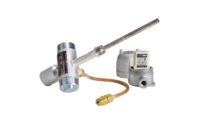Plugged In To Candy
Consumer electronics retailer Circuit City finds that candy is dandy for the bottom line.
Candy and consumer electronics enjoy a sweet coexistence in more than 600 Circuit City stores nationwide.
Which is exactly what Brian Keller had in mind when he
launched a candy initiative at the chain about two years ago. A veteran of
20-plus years at Circuit City, a Fortune 500 provider of consumer
electronics products, Keller has served stints in store operations, in the
training department, and on the Six Sigma business improvement methodology
team. Part of the latter group’s mandate was figuring out ways to
generate new revenues for Circuit City, and Keller was convinced that candy
was a strong candidate.
“We started bringing the candy in during October
2004 and had it rolled out to every store by January 2005,” Keller
reports. “We’ve expanded, and I’m expanding further. The
company is very pleased with the kind of profit margin this generates.
It’s a nice add-on sale. And it’s a great customer service
… for the customer who has been out shopping for a while and has got
a little hunger or thirst going. (Beverages also are sold at the front end
of the stores.)
“It doesn’t take away anything from our
core business, which is to sell consumer electronics,” Keller
summarizes.
Candy is displayed at two locations in Circuit City
outlets — at the checkout and with the DVDs. At the checkout, a
three-foot-long, double-sided “Sweet Spot” display fixture
shows off nearly 70 candy SKUs. “It stands kind of proud,” says
Keller, who credits the fixture’s simple design and crisp graphics
with making the candy rollout “successful right out of the
gate.”
“We were trying to do candy the Circuit City
way, which was to give it a face and really make it a department,” he
adds.
In the wake of the Sweet Spot rollout, about
two-thirds of Circuit City stores have added a small rack for gum at the
front register. Next up for the front end will be more salty snack SKUs,
Keller reports. The chain already sells nuts, trail mix and some meat
snacks at the front end.
“I’ve been working with my space planning
and store environments group to come up with a way to display all of these
products so it doesn’t look like it was done by some guy trying to
run a Kool-Aid stand,” Keller continues with characteristic wry
humor.
A sweet combo
The secondary location for candy is smack dab in the
middle of Circuit City’s highest-traffic zone, the DVD department.
About 30 theater box candy varieties are featured on three power panels
housed in the department; the assortment also includes a single SKU of
microwave popcorn. Point-of-sale signs encourage shoppers to “make it
a movie night.”
Merchandising candy with the DVDs makes for a logical
pairing, says Keller. “People are used to buying candy at the
movies,” he says. “Movie candy is about $3 or $4; our prices
are dramatically less, so it’s almost a no brainer:
‘We’re going to watch a movie tonight. Let’s get some
Junior Mints and Sno-Caps.’ And because our selection is broader than
in the typical theater, I think people tend to buy a little more.”
Selling DVDs is a fiercely competitive, low-margin
proposition, so positioning candy adjacent to them and developing DVD/candy
tie-in offers delivers a nice bit of profit margin enhancement. About 80
percent of a new release’s sales occur in the first 30 days it is on
the market, Keller explains. “Everybody is going to advertise it at a
hot, low price,” he says. “So we’ve got a hot, low price.
We’re not making a lot of money on it. By being able to have a candy
tie-in, we can improve that.”
Movie-themed licensed candy is a natural for this
purpose, says Keller, noting that he brought the PEZ Star Wars
Collector’s Set candy dispensers into the stores prior to Christmas
and even featured them in national Circuit City advertising.
For the “King Kong” DVD release, Circuit
City offered a free king-size Nestlé candy bar with purchase of the
DVD. And with the release of the “Charlie and the Chocolate
Factory” DVD, what else for a giveaway but free Wonka chocolate bars?
(Consumers actually had a choice of either the Wonka bar or Wonka Donutz
candy, Keller notes.)
In this environment, having candy on hand is a
convenience for the consumer, and the Circuit City pricing strategy for
candy reflects that. “It’s a matter of having the right product
at the price they’re willing to pay,” says Keller. In a welcome
contrast to the DVD business, “it doesn’t have to be the lowest
price in town,” he adds.
What works at Circuit City
Theater box candy is one of the star attractions in
Circuit City’s candy assortment, but thanks to the chain’s
predominantly male shopping demographic, beef snacks are doing well too,
adds Keller. “The Circuit City customer is about a 43-year-old male,
and guys like beef,” he notes.
Because that male shopper often arrives at the store
with his kids in tow, candy SKUs targeted to the younger set are strong
performers as well. “That was something of a surprise to us,”
says Keller. “I didn’t expect it to be as big as it is.
“We do a nice business in sours and what are
traditionally kids’ candy items,” says Keller.
“Twizzlers, Sour Patch Kids and Swedish Fish — those three
items are in our Top 10.” Other big winners: Signature Snacks’
Flipz chocolate-covered pretzels and Jelly Belly jelly beans in a 5.1-ounce
box. “They’re flying off the shelf,” says Keller of the
latter item, which is housed in the DVD department and packaged in what he
describes as “kind of like a vertical theater box.”
With the exception of licensed candy items that tie
into DVD movie releases, and the occasional hot prospect in and out,
Circuit City steers clear of most temporary merchandisers, says Keller.
Store traffic in a specialty store isn’t as robust as in a
supermarket or mass merchandiser, so it may take four or five months for a
shipper to sell through, says Keller, noting that by that point it tends to
look “ratty.”
Keller credits his distributor, Phoenix-based Liberty
Distribution, with providing valuable assistance in the assortment
selection process. “Liberty was instrumental in helping us pick out
top sellers across the nation so that we’d have a starting point that
was robust,” he says. Since then, Keller notes, he has culled the
assortment, pulling about a dozen SKUs and giving some new items a try.
Most of the originally chosen SKUs have been winners, however, as has the
overall candy concept, he notes.




